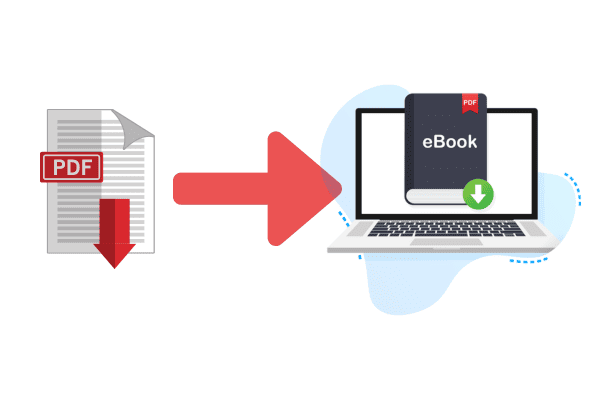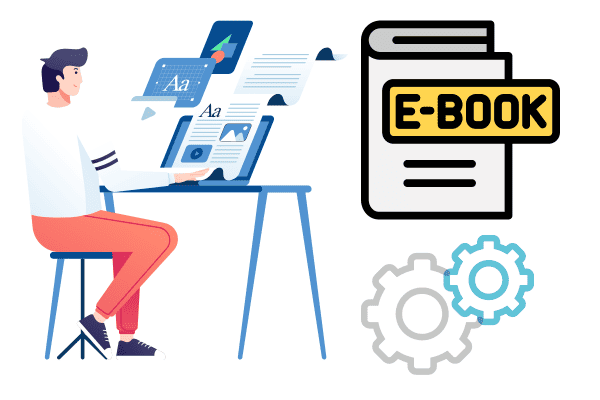Create eBook from PDF: Best Practices (2023)
The Future of Reading: How to Efficiently Transform PDFs into eBooks
Have you ever wondered “how to create eBook from pdf” on your desktop into a sleek, interactive digital book? You’re not alone. With the surge of electronic publication readers, more people are getting hooked on the convenience of having their favorite reads in flipping books or mobi formatting.

Creating a digital book from a pdf or an epub file isn’t rocket science. It’s all about understanding the conversion process and the right tools for the job, like Flippingbook or other formatting tools. And guess what?
There are free options available! So whether you’ve got a novel, a guide, or a report in pdf format, it’s high time you learned how to convert it into an engaging digital book.
The rise of ebooks, particularly in epub format, is no fluke; they’re portable, easy-to-read epub files that have taken over traditional pdfs by storm. But why stop at just reading them when you can become a creator using Flippingbook?
This article will guide you through different methods to convert your pdf files into an exciting ebook format, such as an epub or even a mobi file for Kindle users, a crucial part of ebook creation.
Before starting this conversion journey, we’ll also discuss basic ebook readers’ requirements. Additionally, we’ll briefly discuss marketing your ebook.
Get ready, future ebook creator! It’s time to utilize Flippingbook and transform those static portable document format files into interactive ebooks in an epub format that will wow your audience with their formatting.
Benefits of Transforming PDF into eBook
Enhanced Readability
Ever tried squinting at a PDF on your smartphone? It’s no fun, right? Creating a flipping book in epub format from a PDF makes the content way more readable on various devices.
With proper formatting, you can zoom in and out without losing clarity, adjust font size, and even change the background color for night mode reading. It’s like having a personal book tailored to your writing! Plus
- eBooks, particularly in epub format, are easy to read on eReaders like Kindle or Nook. You can convert these to adobe pdf or Flippingbook for versatile reading options using a pdf editor.
- They look great on tablets and smartphones.
- Even desktop users get a better reading experience.
Would you rather wrestle with a stubbornly static PDF or flip through an interactive flipping book in an epub format that adjusts to your needs with slide and formatting features?
Increased Accessibility and Portability
Remember lugging around hefty textbooks in school? Not anymore. With eBooks in epub format, you’ve got an entire library in your pocket right on your flipping book! Here’s how a pdf editor can transform a bulky pdf file into a portable library.

- eBooks, particularly in epub format, are as light as a feather (literally). You can carry hundreds on your device, like a flipping book or adobe pdf file, without sweat.
- No need for internet access once your electronic book is downloaded. Read your pdf ebook on ebook readers anywhere, anytime, regardless of the ebook format!
- Easy sharing of your epub or pdf ebook with friends or colleagues – send them the flipping book file or share your free templates via cloud storage.
So why stick to old-school PDFs when you can create an epub eBook that goes wherever you go? This post explores the reasons.
Interactive Content Inclusion
PDFs are pretty much set in stone – but eBooks? They’re playdough in your hands! You can include interactive content like videos, links, quizzes…the sky’s the limit!
For instance:
- Embed YouTube tutorials into DIY guides
- Include hyperlinks for easy reference navigation
- Use an interactive ebook creator to add quizzes at the end of educational content for self-assessment. Utilize free ebook templates and save your work as a pdf file.
Interactive content makes learning fun and helps readers retain information better. So why settle for monotonous PDFs when you can create engaging eBooks?
Environmentally Friendly Option
Do you know what’s cooler than being cool? Being green! Creating eBooks from PDFs is one step towards reducing paper usage.

Consider this:
- No trees were chopped down to make paper.
- Less energy is used in printing and distribution.
- The lower carbon footprint from reduced shipping.
In other words: every time you create an eBook instead of printing a PDF, Mother Nature gives you a high-five!
Cost-effective Distribution and Marketing Strategy
Let’s talk, moolah! Converting your PDFs into eBooks isn’t just good for readers and your wallet!
Here’s why:
- No printing costs mean higher profit margins.
- Digital distribution is faster and reaches wider audiences.
- The perfect tool for email marketing campaigns – attach and send your interactive ebook created with our free ebook creator!
In short: creating eBooks from PDFs is like getting premium ad space without burning through your budget.
So there we have it, folks – five fantastic reasons to turn those drab old PDFs into dynamic new eBooks. Whether it’s enhanced readability or cost-effective marketing strategies, the benefits are clear as day. So what are we waiting for? Let’s start transforming those files today!
Essential Tools for PDF to eBook Conversion
Software Tools Overview
You’re probably wondering, “How do I create an ebook from a pdf?” Well, it all starts with the right tools. Think of it like baking a cake. Having the right ingredients and equipment to complete the job would be best. In this case, your main ingredients are software tools such as Adobe Acrobat and Calibre.

Adobe Acrobat is a versatile tool that’s more than just a simple pdf editor. It allows you to edit, create, export, and sign pdf files. Its comprehensive features will enable you to convert your pdf documents into an engaging ebook easily.
On the other hand, Calibre is like your handy kitchen gadget that makes life easier. It’s an open-source ebook library management application that supports various formats, including PDFs. Converting your pdf file into an ebook using Calibre is as easy as pie.
Choosing The Right Tool
Like picking out the perfect recipe for your cake, choosing the right interactive ebook creator depends on your needs. Do you want a straightforward ebook conversion tool, or do you prefer to have extra features?
Remember:
- Adobe Acrobat, an interactive ebook creator, is feature-packed but has a price tag.
- While Caliber is free and easy to use for creating interactive ebooks, it may lack some advanced features found in Adobe Acrobat.
So ask yourself: What do I value more in an interactive ebook – cost or functionality?
Features To Look Out For
Now let’s discuss what makes a good conversion tool for an interactive ebook.
- Format Integrity: Does it maintain the original layout during conversion?
- Ease-of-use: Is it user-friendly?
- Support: Does it support different file formats?
- Price: Is it worth my money?
These are just some of the things to consider when choosing your tool.
Role Of Conversion Tools
Conversion tools are crucial in maintaining format integrity during the conversion process. Imagine pouring batter into a pan only to find out later that it didn’t hold its shape while baking – frustrating!
The same goes for converting pdf files into ebooks; readers might lose interest if the layout gets messed up during conversion.
These tools are essential; they ensure everything stays in place during conversion – from text alignment down to image placement.
Ease-of-use Factor
Lastly, let’s not forget about the ease-of-use factor because who wants complicated stuff anyway? A good conversion tool should be simple without getting lost in technical jargon or confusing instructions.
To sum up:
- Adobe Acrobat offers powerful editing capabilities but might be overwhelming for beginners.
- Calibre provides simplicity and convenience, making it perfect for those who prefer hassle-free conversions.
FlippingBook Online: A Comprehensive Guide
FlippingBook is not your typical online converter tool. The Swiss army knife of ebook creation transforms static PDFs into interactive ebooks with a flipping animation effect, making every page turn feel like you’re flipping through a physical book.
Step-by-Step Guide to Using FlippingBook
- Kick things off by visiting the FlippingBook website. The landing page has an intuitive design, making it easy for first-timers.
- Your first step? Click on ‘Upload PDF.’ This button stands out, so you can’t miss it!
- Now, select the PDF file you want to convert into an ebook.
- Once uploaded, let FlippingBook do its magic! In no time, your PDF will be transformed into an interactive ebook with flip animation effects.
- You can then customize your ebook further by adding diagrams or slides.
FlippingBook isn’t just about converting PDFs to ebooks; it’s about creating an immersive reading experience.
Unique Features of FlippingBook
FlippingBook offers a plethora of special features:
- Flip Animation Effect: Makes every page turn feel real and engaging.
- Customization Options: Add diagrams or slides to enhance reader engagement.
- Shareability: Share your ebook on any platform with ease.
With these features, creating compelling ebooks is as easy as pie!
Pricing Plans of FlippingBook
Now let’s talk dollars and cents! Here are the pricing plans offered by FlippingBook:
| Plan | Price |
|---|---|
| Starter | $32/month |
| Optimal | $99/month |
| Advanced | $299/month |
Each plan has its features and benefits tailored to different needs and budgets.
User reviews rave about the efficiency of this tool. “The best thing since sliced bread!” one user exclaimed, while another said, “It’s like having my publishing house.
Advantages of Using PDFelement Pro
OCR Technology and Batch Processing
Ever had a stack of documents to convert but dreaded the thought of doing it individually? PDFelement Pro is your knight in shining armor. With its batch-processing feature, this software allows you to convert multiple files at once.
It’s like having your assembly line for document conversion.
But that’s not all. The OCR (Optical Character Recognition) technology takes this software to another level. Imagine having a scanned document you can’t edit because your computer sees it as an image.
With OCR, PDFelement Pro can recognize text in scanned documents, making them editable. It’s like having a pair of X-ray glasses that see through the uneditable facade of scanned docs.
Intuitive Interface Design
PDFelement Pro doesn’t just do the heavy lifting but also ensures you enjoy the ride. Its intuitive interface design simplifies complex editing tasks during conversions. You don’t need to be a tech guru or spend hours on YouTube tutorials figuring out how to use this tool.
Think about it like playing with Lego blocks – everything fits perfectly, and even if you’ve never done it before, you instinctively know what goes where.
Security Features
Let’s talk security features because we all love our privacy, right? With PDFelement Pro, you can add passwords to your documents for an added layer of protection. Moreover, there are watermark addition capabilities so everyone knows the rightful owner.
It’s like having a state-of-the-art home security system protecting your precious files from unwanted intruders and leaving no doubt about who they belong to.
Superior Performance Aspects
When pitted against other similar tools, PDFelement Pro shines brighter than a diamond in terms of performance aspects such as speed and accuracy. Converting documents is faster than Usain Bolt on race day and more accurate than Sherlock Holmes’s deductions.
In short, if converting documents was an Olympic sport, PDFelement Pro would bag all gold medals!
Compatibility Across Multiple Platforms
Lastly, let’s discuss compatibility because nobody likes being left out! Whether you’re team Windows or Mac OS X or prefer working on iOS & Android devices, PDFelementk Pro has your back! It seamlessly works across these platforms without throwing tantrums or giving compatibility issues.
But wherever you go, whatever device you use – PDFelement Pro follows!
So, folks, those were some critical advantages of using PDfelement Pro when creating ebooks from pdfs.
PDF to eBook Conversion on Mac
Hey there, Mac user! So, you’ve got a PDF file and want to turn it into an eBook? You’re in the right place. Let’s dive straight into it.
Using Preview App
First up is your trusty sidekick, the built-in Preview application. This nifty little tool can do more than just let you sneak a peek at your files.
- Open the PDF with Preview.
- In the menu bar, click ‘File’’ then ‘Export as PDF…’.
- Save your new file where you want it.
Easy peasy lemon squeezy! But hold your horses – this method doesn’t always work like a charm. For instance, if your PDF has complex formatting or images, they might go haywire during conversion.
So what’s a Mac user to do when faced with such hiccups? Fear not! There are other tools in our arsenal we can use.
Third-Party Software
Enter stage right: Calibre and Adobe Acrobat Pro DC. This software is like Swiss Army knives for handling eBooks – they can slice through any conversion challenge you throw!
Caliber
Let’s start with Calibre:
- Download and install Calibre.
- Open Calibre and click ‘Add books’ to upload your PDF.
- Click on ‘Convert books.’
- Choose your desired output format (e.g., EPUB) and hit ‘OK.’’
Voila! Your eBook is ready.
Adobe Acrobat Pro DC
Next up is Adobe Acrobat Pro DC:
- Download and install Adobe Acrobat Pro DC.
- Open the software and click on ‘Tools,’ then select ‘Create PDF.’’
- Upload your file.
- Once uploaded, click ‘File’’ then choose ‘Save As Other…’, followed by ‘EPUB.’’
And there you have it – another eBook hot off the press!
But wait a minute – don’t forget about tweaking specific settings before converting!
Settings Adjustments
When using third-party software like Calibre or Adobe Acrobat Pro DC, make sure to adjust settings for optimal results:
- Metadata: Update details like title, author name, etc.
- Layout: Choose how you want text & images arranged.
- Table of Contents: Decide whether or not to include one.
Tweak these settings based on what suits your needs best!
Tips & Tricks
Here are some insider tips exclusively for Mac users:
- Use keyboard shortcuts for quick conversions (Cmd + S in Preview).
- Regularly update third-party software for best performance.
- Always preview converted files before sharing or publishing them.
Remember these tips next time you convert a PDF to an eBook!
Best-Rated Softwares
Apart from Calibre and Adobe Acrobat Pro DC, here are some other top-rated third-party software compatible with macOS :
| Software | Rating |
|---|---|
| PDFelement | 4/5 |
| Aiseesoft Mac PDF Converter Ultimate | 4/5 |
| Nuance PowerPDF Standard | 3/5 |
Each has its features, so pick one that fits your needs perfectly!
Creating an eBook from a PDF on Mac isn’t rocket science – all it takes is knowing which tool works best for you and how to use it effectively! So go ahead – get converting!
How to Import Drafts for Conversion
The Nitty-Gritty of Importing Drafts
So, you’ve got your drafts ready, and it’s time to import them into your chosen converter tool. Picture this: it’s a bit like moving house. You’ve packed up all your belongings (your drafts) and now must transport them to their new home (the converter tool). But how do you go about doing this?
- First off, open up your converter tool.
- Next, look for the “import” or “upload” button. It might be hidden in a drop-down menu or the corner.
- Click on that button and navigate to where your draft is saved on your computer.
- Select the draft you want to import and click ‘open’ or ‘upload.’’
But wait! Before you hit that import button, take a moment to check what file format your draft is in.
File Formats: Friend or Foe?
Like people prefer different coffee types, converter tools have preferences, too – they like specific file formats more than others. If you try giving an espresso drinker a cup of instant coffee, they won’t be happy about it!
Similarly, if you try importing a file type that isn’t compatible with your converter tool, things won’t go smoothly.
To avoid any hiccups during the import process:
- Check which file formats are supported by your converter tool before starting.
- Convert any incompatible files into a suitable format using another software before importing.
Now we’re cooking with gas!
Troubleshooting Tips and Tricks
However, issues can crop up during draft importation even when everything seems perfect on paper (or screen). Not unlike assembling flat-pack furniture – sometimes things just don’t fit together as expected! Here’s what you can do if trouble strikes:
- Double-check the file format compatibility.
- Ensure no special characters in the file name might upset the software.
- Make sure there’s enough storage space available for the imported files.
Remember: patience is key here!
Organizing Your Drafts
Before diving headfirst into converting those drafts into an ebook from PDF format, take time to organize them – trust me; it’ll save headaches later! Think of it like sorting through Lego pieces before building – having everything sorted makes assembly much more accessible!
Here are some tips:
- Group related content together
- Number chapters/sections sequentially
- Keep track of versions/revisions
The organization will pave the way for smooth sailing during the conversion process.
Save Early, Save Often
Finally – and I cannot stress this enough – save early and often throughout the importation stage! Like remembering to keep progress while playing video games to avoid losing hard-won achievements, regularly keeping drafts ensures all changes are recorded.
Consider setting reminders or alarms every 10 minutes as prompts for saving work – better safe than sorry!
So there we have it, folks – our guide on how-to-import-drafts-for-conversion while creating an ebook in PDF format. Remember these steps when embarking on the conversion journey next time around!
Crafting Interactive eBooks for Businesses
The Business Boom of eBooks
Let’s explore how interactive eBooks can give your business a competitive edge. Imagine you’re a customer, wouldn’t an eBook that interacts with you be more engaging than a static PDF? Of course! It’s like comparing black and white TV to color – there’s no contest.
Interactive eBooks can take your business from being just another name in the crowd to becoming a thought leader in your industry. They boost customer engagement by making content consumption fun.
A well-designed interactive eBook can improve brand visibility, helping your product stand out.
Think about it this way – when people interact with something, they remember it better. So, if potential customers interact with an eBook about your product or service, they’re more likely to remember you when they need what you offer. Talk about lead generation!
These businesses knew how to leverage interactivity effectively; they didn’t just create ebooks from pdfs but transformed them into powerful marketing tools.
Designing Business-Oriented eBooks
When designing an interactive eBook for business purposes, here are some strategies worth considering:
- Understand Your Audience: Know who will read your eBook and what they want from it.
- Plan Your Content: Ensure it aligns with your audience’s needs and business goals.
- Choose Appropriate Interactivity Elements: Quizzes, surveys, and embedded videos are all great options but use them wisely not to overwhelm or distract readers.
Remember – the goal is to entertain and educate readers about your product or service.
Popular Interactive Elements
Interactive elements breathe life into an otherwise static document; here are some commonly used ones:
- Quizzes: Test reader understanding and reinforce essential points
- Surveys: Collect reader feedback or opinions
- Embedded Videos: Demonstrate complex concepts visually
- Clickable Infographics: Present data in a digestible format
Each element has its benefits but chooses those that best serve your content and audience.
Balancing Interactivity & Readability
While interactivity is excellent, too much of it can be distracting rather than enhancing the reading experience. So how do we strike that balance?
Firstly, don’t force interactivity that doesn’t fit naturally within your content flow. Second, ensure every interactive element serves a purpose, whether reinforcing learning, collecting feedback, or demonstrating concepts.
Incorporating these precautions will make sure you don’t sacrifice readability for interactivity. After all, we want our audience glued to the last page, right?
So go ahead, and give this strategy a shot. Create ebooks from pdfs that engage, educate, and excite!
Incorporating Interactive Elements in eBooks
Interactive Elements Types
Interactive ebooks have revolutionized the reading experience. They are not just electronic books but digital books with elements that engage learners and make reading more enjoyable. Let’s dive into the different interactive features that can be added to an eBook.
- Video Content: Embedding video content in an ebook is like adding a cherry on top of a cake. It makes content more engaging for readers who prefer visual learning. For example, if you are creating an ebook about cooking, you can include videos demonstrating how to prepare each dish.
- Clickable Images: Clickable images add value to your ebook by providing additional information or resources related to the text. Consider using images complementing your content and encouraging readers to click for more details.
- Interactive Quizzes: These are great tools for assessing understanding and retention of knowledge. They provide immediate feedback, helping learners identify areas they must focus on.
Strategic Placement Tips
Discuss strategically placing these interactive elements within your content without disrupting the flow.
- Contextual Placement: Always place interactive elements where they make sense contextually. If you’re talking about a complex concept in your text, right after explaining, it would be a good spot for an explanatory video.
- Balanced Distribution: Avoid clustering all interactive components in one book section; distribute them evenly throughout.
- Mind The Colors: Ensure the color scheme of your interactive elements complements the overall design aesthetic of your ebook.
Enhancing Reading Experience
Interactive ebooks do more than provide information; they create immersive experiences that keep readers hooked from start to finish:
- They cater to diverse learning styles: visual learners benefit from video content and images, and kinesthetic learners appreciate being able to interact with the text.
- Interactive quizzes at the end of sections allow readers to test their understanding immediately.
Testing Before Publishing
Testing is crucial before final publishing:
- Check functionality: Ensure all links, videos, and quizzes work correctly.
- Evaluate effectiveness: Gather feedback from test users about their experience interacting with these components.
Technical Aspects To Know
Lastly, here are some technical aspects related to embedding each type of element:
- Video Content: Ensure the file size isn’t too large, which might slow down loading times.
- Clickable Images: High-resolution images can increase file size; compress them without losing quality.
Creating an interactive eBook involves much more than simply converting a PDF file into digital format; it requires thoughtful placement and selection of engaging components that enhance learning while keeping reader enjoyment front-of-mind!
Enhancing Navigation and Sharing Capabilities
The User-Friendly eBook
Let’s cut to the chase. You want to create an ebook from a PDF. But it’s not just about converting one file format to another. It’s also about making your ebook user-friendly. Think of it this way.
Your readers are on various devices, accessing your content through different platforms. If they can’t navigate easily through your ebook, chances are they’ll give up and move on.
So what can you do? First off, improve the navigation system within your ebook.
- Use logical structuring in your Table Of Contents (TOC). Break down chapters into smaller sections or even sub-sections if needed.
- Include links that take readers directly to specific pages or sections.
- Offer search features for quick access to specific topics or keywords.
By making these changes, you’re making life easier for your readers and getting valuable feedback on how people use your content.
Shareable Content is King
Next up: sharing capabilities. Let’s face it. We live in a generation where sharing is caring—especially.
Here are some options:
- Allow readers to share excerpts or highlights directly onto social media platforms.
- Enable email sharing with pre-filled subject lines and body text that include a link back to the ebook.
When done right, this action could help boost visibility across different marketing channels and reach more of your target audience.
Metadata Optimization Matters
Have you ever heard of metadata optimization? It plays a crucial role in increasing discoverability when shared online. Optimizing metadata helps future-proof your ebooks by ensuring they get found by the right people in the right way.
For example:
- Use relevant keywords in title tags, meta descriptions, and headers
- Include author information for added credibility
- Add category tags for better classification
Remember: Every little detail counts!
Judging an eBook by Its Cover
Finally, let’s talk about cover design because people still judge books by their covers! A well-designed cover page can significantly impact sharing rates among readers.
Consider these factors:
- Color Scheme: Choose colors that resonate with your audience and match the tone of your content.
- Typography: Pick fonts that are easy to read yet appealing.
- Imagery: Opt for high-quality images that reflect what’s inside the book.
A great cover isn’t just visually pleasing and provides a sneak peek into what readers can expect!
Writing, Formatting, and Publishing eBooks
Quality Content Creation
Creating an ebook from a PDF starts with writing high-quality content that resonates well with your target audience. This process involves:
- Conducting in-depth research on your topic.
- Identifying the needs and interests of your audience.
- Creating engaging and informative content.
Remember, writing is not just about putting words together; it’s about telling a story your readers can connect with.
Ebook Formatting Tips
Once you’ve written your content, the next step is to format it for readability and visual appeal. Here are some tips:
- Use consistent font styles and sizes throughout the text.
- Break up large blocks of text into smaller paragraphs or bullet points to make them easier to read.
- Include images, charts, or graphs where appropriate to enhance understanding.
- Take advantage of free ebook templates available online to ensure a professional look.
Formatting doesn’t just improve aesthetics; it also enhances the overall reading experience.
Proofreading Importance
Before publishing an ebook, proofreading is essential. It helps eliminate errors, ensuring a professional finish is maintained. Here’s how you can do it effectively:
- Read your content multiple times, focusing on different aspects (grammar, punctuation, flow, etc.).
- Use tools like Grammarly or Hemingway Editor for additional help.
- Consider hiring a professional proofreader if possible.
Proofreading ensures that your final product is polished and error-free, ultimately impacting the reader’s perception of its quality.
Publishing Process Guide
Publishing an ebook involves several steps, including choosing the right platform based on the authors’ specific needs/goals/target audience/etc., Some popular platforms include Amazon Kindle Direct Publishing (KDP), Smashwords, and Lulu, etc.; each has its pros & cons, such as royalty rates, market reach, etc., So research thoroughly before making a decision.
Legalities Around Ebook Publishing
When publishing an ebook, there are several legal considerations such as copyright laws/ISBN registration/etc., You need to ensure that all content in your book is original or credited adequately if sourced from elsewhere. Registering for an ISBN isn’t mandatory, but having one makes your book more discoverable across various platforms.
Mastering PDF to eBook Conversion
Mastering the art of converting PDF files into eBooks is a game-changer. It opens up opportunities, from creating interactive business content to enhancing navigation and sharing capabilities.
PDFelement Pro and FlippingBook Online are two tools that have proven invaluable in this process. They provide a comprehensive guide on importing drafts for conversion, incorporating interactive elements, and even improving the overall user experience.
Creating an eBook from a PDF isn’t just about conversion; it’s also about crafting engaging content. That’s why writing, formatting, and publishing eBooks are vital skills you need to hone.
Incorporating interactive elements in your eBooks can make them more engaging. These elements range from clickable links and buttons to embedded videos and animations.
Navigation is another crucial aspect of your eBook. Enhancing it means making it easier for readers to find what they’re looking for in your book—a specific chapter or a reference section.
Sharing capabilities allow your readers to share your eBook with others easily. This can significantly increase its reach and potentially bring in more readers.
So there you have it—the key points you must master when converting PDFs into eBooks. Now go out there and start creating!
FAQs – Create eBook from PDF
What are the benefits of transforming PDF into eBook?
Converting PDFs into eBooks allows for greater interactivity, better navigation, and more accessible sharing capabilities, among other benefits.
Which tools do I need for PDF to eBook conversion?
Many tools are available, but some popular ones include PDFelement Pro and FlippingBook Online.
How does incorporating interactive elements enhance my eBook?
Interactive elements such as clickable links or embedded videos can make your content more engaging, leading to higher reader retention rates.
Why should I focus on enhancing navigation in my eBook?
Good navigation makes it easy for readers to find what they’re looking for in your book, improving their reading experience and increasing their likelihood of recommending your book to others.
Can I convert PDFs into eBooks on Mac?
Yes! There are several tools available that allow you to convert PDFs into eBooks on Mac.
We’re reader-supported. We may earn an affiliate commission when you buy through links on our site.

Angus Robertson is an authority in online marketing, affiliate marketing, and Search Engine Optimization (SEO). With an innate passion for the digital world, he has spent the last two decades assisting businesses in amplifying their online presence and boosting profitability.







